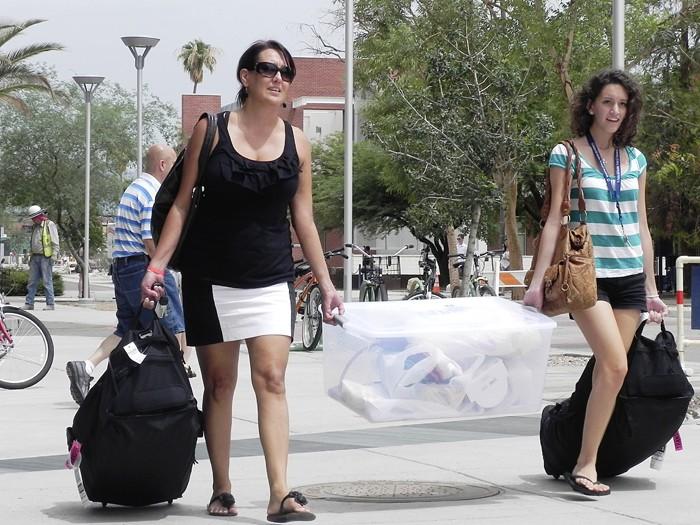Months of waiting and checking online for roommate assignments ended for the 6,400 students who moved into the residence halls last week.
The record-breaking number of on-campus residents checked into 24 different residence halls over a three-day period. About 80 percent are freshmen, according to Jim Van Arsdel, director of Residence Life.
He said the amount of students living on campus is trending upward and the number is directly linked to freshmen enrollment.
With the exceptions of 2002 and 2004, UA fall freshmen enrollment has increased every year since 1999 and stood at 7,025 as of 2010, according to the Office of Institutional Research and Planning Support.
Lwiindi Mumba, a pre-pharmacy freshman living in Manzanita-Mohave Residence Hall, said she had no concerns about living on campus besides sharing a bathroom, and was excited to be there.
Felix Valencia, an undeclared sophomore and returning resident, said living in Babcock Residence Hall will allow him to keep take advantage of social opportunities.
“Plus I’m not that eager to pay for utilities, I can barely afford textbooks,” he added.
The increasing number of students staying in the residence halls has created an issue of overcrowding in the dorms. As long as the UA continues to offer a high level of academic and social programming, people will continue to live on campus, Van Arsdel said.
“We have this problem that everyone on Earth wants,” Van Arsdel said.
Closing residence halls for maintenance and renovations could exacerbate the problem for the growing number of students wanting to live on campus.
Coronado Residence Hall is closed for the academic year because of plumbing and mechanical system renovations. Van Arsdel said improvements are going well and that student rooms will have new carpet, paint and furniture.
Study rooms being converted into sleeping quarters, students rooming with resident assistants and rooms filling to triple occupancy have become common practice to accommodate the high number of residents, Van Arsdel said. Depending on their waiting list status, students could stay in temporary housing anywhere from a day to a semester.
Van Arsdel said that because there would be more resident assistants, and they should not worry about being burdened with more than their fair share of responsibilities due to the high number of residents.
Rebecca Covarrubias, a psychology graduate student living at the La Aldea graduate housing complex, said she did not think La Aldea would reach occupancy and that she was not worried about overcrowding.
“It’s expensive housing. It would be nice to have La Aldea full, but that’s a really ambitious goal,” she said.
With the addition of two new dorms, Árbol de La Vida Residence Hall and Likins Hall, the UA will increase its on-campus residential housing capacity by more than 1,000, or 18 percent.
Van Arsdel said gauging the amount of incoming residents and building more residence halls as needed will help handle any overcrowding. The energy efficient focus of Árbol de la Vida and Likins Hall will have a big impact on slashing costs. Other residence halls are already following their lead. Posada San Pedro Residence Hall will receive photovoltaic panels that will produce energy for the building, according to Van Arsdel.
Van Arsdel added that he said hopes the residence halls will compete with each other to be the most energy efficient. Dashboard systems, which will broadcast utility usage, will help track energy use.
“When a student cranks up the air and opens their window, there’s a lot of money flying out that window,” he said. “We want to challenge the students to learn about the consequences of their decisions.”
Looking toward the future, Van Arsdel said proper planning would be the key to maintaining the UA’s high quality of campus housing.
“You have to begin with concepts and ideas, not concrete and mortar,” Van Arsdel said.









